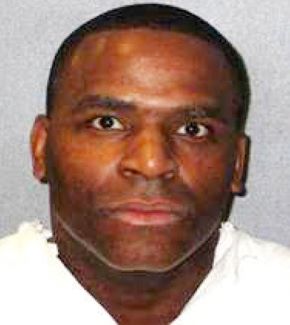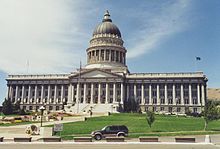
Execution by firing squad, in the past sometimes called fusillading, is a method of capital punishment, particularly common in the military and in times of war. Some reasons for its use are that firearms are usually readily available and a gunshot to a vital organ, such as the brain or heart, most often will kill relatively quickly.
Capital punishment is a legal penalty in the U.S. state of Arkansas.
Capital punishment is a legal penalty in the U.S. state of Utah.

Joseph Paul Franklin was an American serial killer, white supremacist, and domestic terrorist who engaged in a murder spree spanning the late 1970s and early 1980s.

John Albert Taylor was an American who was convicted of burglary and carrying a concealed weapon in the state of Florida, and sexual assault and murder in the state of Utah. Taylor's own sister tipped off police in June 1989 after 11-year-old Charla King was found raped and strangled to death in Washington Terrace, Utah. His fingerprints were found at the crime scene, which was located in an apartment complex where he had been staying. In December 1989, Taylor was sentenced to death and placed on death row at Utah State Prison.

Potosi Correctional Center (PCC) is a Missouri Department of Corrections prison located in unincorporated Washington County, Missouri, near Mineral Point. The facility currently houses 800 death row, maximum security and high-risk male inmates.

Utah State Prison (USP) was one of two prisons managed by the Utah Department of Corrections' Division of Institutional Operations. It was located in Draper, Utah, United States, about 20 miles (32 km) southwest of Salt Lake City. It was replaced by the Utah State Correctional Facility in July 2022.

James W. Rodgers was an American who was sentenced to death by the state of Utah for the murder of miner Charles Merrifield in 1957. In his final statement before his execution by firing squad in 1960, Rodgers requested a bulletproof vest. His execution by firing squad would be the last to be carried out in the United States before capital punishment was halted by the U.S. Supreme Court. The death penalty was reinstated in 1976 and the first person executed in Utah subsequent to that date was Gary Gilmore in 1977.
Capital punishment in Connecticut formerly existed as an available sanction for a criminal defendant upon conviction for the commission of a capital offense. Since the 1976 United States Supreme Court decision in Gregg v. Georgia until Connecticut repealed capital punishment in 2012, Connecticut had only executed one person, Michael Bruce Ross in 2005. Initially, the 2012 law allowed executions to proceed for those still on death row and convicted under the previous law, but on August 13, 2015, the Connecticut Supreme Court ruled that applying the death penalty only for past cases was unconstitutional.

John W. Deering was a convicted murderer who was the subject of an experiment to observe what would happen to the human heart during death by gunshot. Deering, an American facing execution by the state of Utah for the May 1938 murder of Oliver R. Meredith Jr., volunteered to have himself hooked up to an electrocardiogram while he was shot by a firing squad. The test indicated that his heart stopped in about 15 seconds of being hit, although other bodily functions, such as breathing, continued for a longer period of time.

Opened in 1969, Georgia Diagnostic and Classification Prison (GDCP) is a Georgia Department of Corrections prison for men in unincorporated Butts County, Georgia, near Jackson. The prison holds the state execution chamber. The execution equipment was moved to the prison in June 1980, with the first execution in the facility occurring on December 15, 1983. The prison houses the male death row, while female death row inmates reside in Arrendale State Prison.

Gary Ray Bowles was an American serial killer who was executed in 2019 for the murders of six men in 1994. He is sometimes referred to as The I-95 Killer since most of his victims lived close to the Interstate 95 highway.

Ronnie Lee Gardner was an American criminal who received the death penalty for killing a man during an attempted escape from a courthouse in 1985, and was executed by a firing squad by the state of Utah in 2010. His case spent nearly 25 years in the court system, prompting the Utah House of Representatives to introduce legislation to limit the number of appeals in capital cases.

Barton Kay Kirkham was a member of the United States Air Force who was discharged in 1955 after committing a robbery in Colorado while absent without leave (AWOL). In 1956, he was sentenced to death after the murder of two grocery store clerks during an armed robbery in Salt Lake City, Utah.

Quintin Phillippe Jones was an American man from Livingston, Texas, who was executed for the 1999 killing of his great aunt, Berthena Bryant. Bryant's family and 183,344 other people petitioned Texas Governor Greg Abbott for clemency to commute his death sentence to a life sentence. He was executed on May 19, 2021, the first execution by the state of Texas in 10 months and only the second since the beginning of the COVID-19 pandemic in March 2020. He was executed without any media presence.

Ernest Lee Johnson was an American criminal convicted and executed for the murder of three convenience store employees in Boone County, Missouri in 1994. Johnson's execution by lethal injection proved controversial, as a 2008 surgery had removed up to 20 percent of his brain tissue, leaving Johnson permanently cognitively disabled.
Taberon Dave Honie was an American murderer and rapist who was executed by the U.S. state of Utah for murdering and raping his ex-girlfriend's mother, Claudia Benn, in 1998. He was the first person to be executed in Utah in over fourteen years, since Ronnie Lee Gardner in June 2010.





















